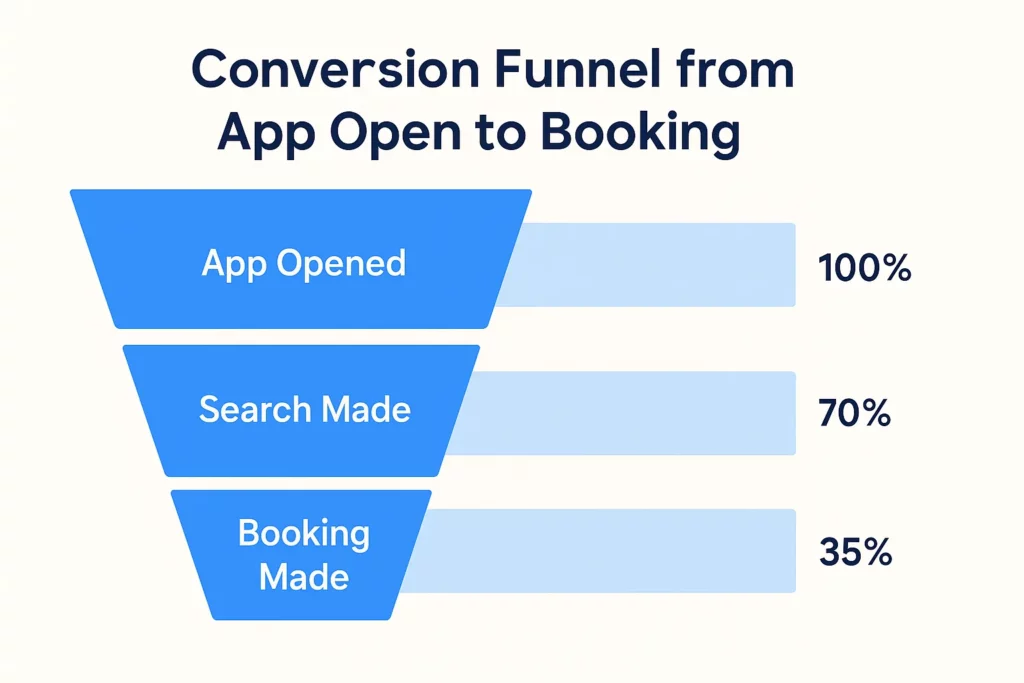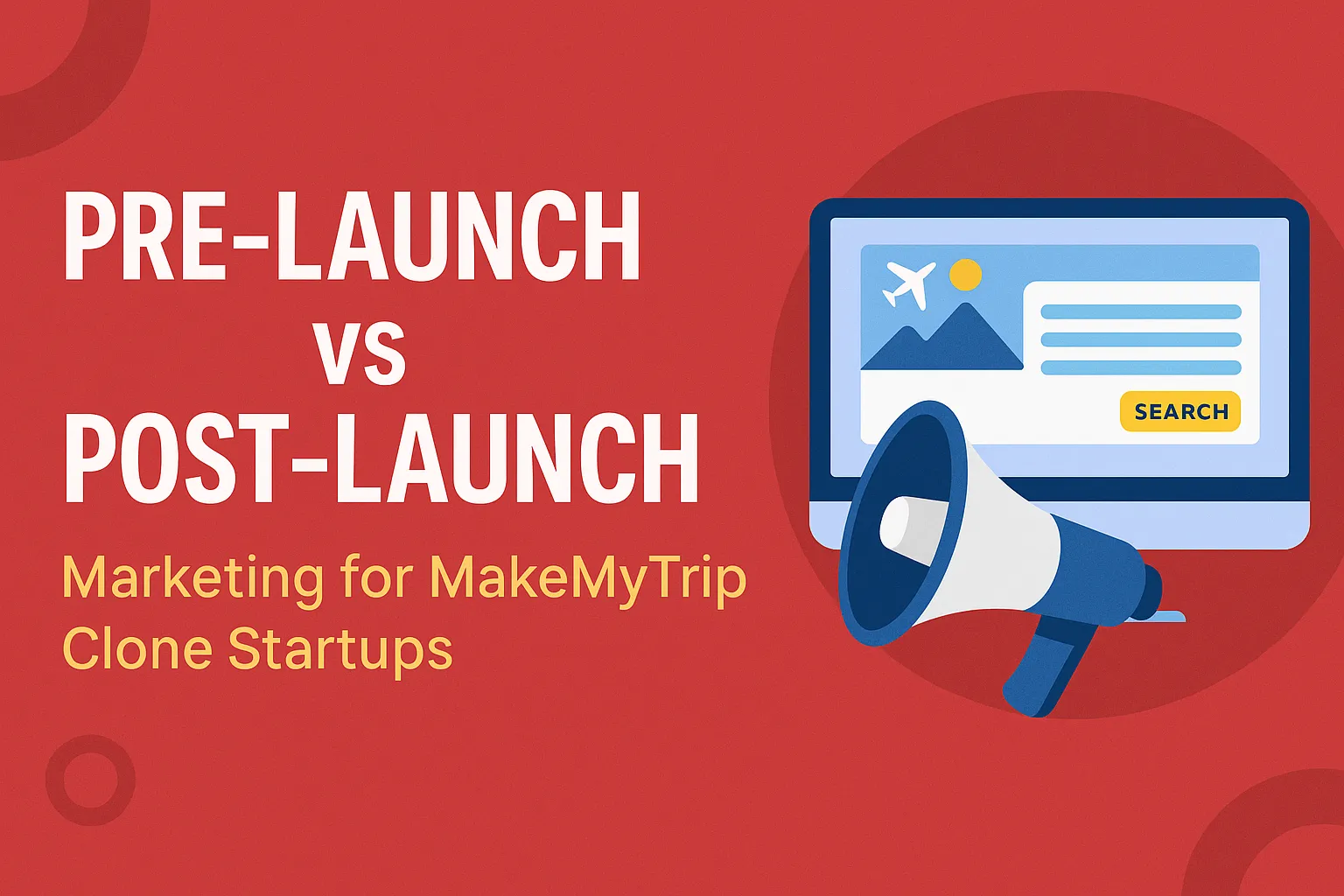If you’re cooking up the next big thing in travel booking—like a Makemytrip clone—you’re probably picturing a sleek app, seamless itineraries, and a tsunami of downloads on Day 1. Sounds dreamy, right? But here’s the plot twist most travel startup founders face: building the app is just 50% of the journey. The other half? Marketing it right—before, during, and after launch.
According to Statista, Think of launching your Makemytrip alternative like opening a grand hotel. You don’t wait for guests to show up before switching on the lights and laying down the red carpet. You start hyping it up before the doors even open. From teasing your launch on social, to influencer collabs, to growing your waitlist—pre-launch efforts can be a serious growth lever.
But that’s only half the equation. Post-launch marketing is where you scale, measure, and optimize to keep the bookings flowing. In this guide, we’ll dive deep into both stages, highlight marketing strategies of Makemytrip, and help you sidestep costly mistakes. If you’re working with a team like Miracuves, you’ll also be armed with a tech partner who gets travel tech inside and out.
Why Both Stages Matter in the Makemytrip Clone Journey & Features
The Travel App Market is Booming (and Crowded)
According to Statista, online travel bookings are expected to hit $1.15 trillion by 2030. This includes everything from flight reservations to hotel aggregators, train tickets, and even last-mile taxi options. But here’s the kicker: the average user has 3+ travel apps on their phone. Which means you’re not just fighting for installs—you’re competing for mindshare.
Learn More: Must-Have Features of MakeMyTrip That Make Travel Effortless
Pre-launch Marketing: Getting on the Radar Early
1. Build a Landing Page That Converts
Don’t wait for your app to be 100% ready. Create a crisp, benefit-focused landing page that captures emails. Use social proof like “1,500+ early travelers have joined the waitlist” to build trust.
Key Tip:Use countdown timers and incentives like “Get $20 off your first booking” for conversions.
2. Start Content Marketing Early
Create blog posts and videos around travel hacks, destination guides, and “Makemytrip alternatives.” This builds organic SEO momentum months before you launch.
3. Partner With Travel Influencers and Micro-creators
Even a few Instagram travel bloggers with niche followings (10k–50k) can spark early interest. Offer them free credits or early access.
4. Leverage Pre-launch Platforms
Sites like Product Hunt, BetaList, and Indie Hackers are goldmines. Engage with comments, drop value, and build anticipation without sounding pitchy.
5. Email Teasers & Countdown Drips
Send behind-the-scenes peeks, upcoming features, or destination spotlights to your waitlist. Build narrative anticipation like a Netflix series drop.
Post-launch Marketing: Keeping Momentum & Scaling
1. App Store Optimization (ASO) Done Right
After launch, your App Store and Play Store listings need love. Use keywords like “cheap flights India,” “hotel booking,” or “Makemytrip alternatives” in your title, description, and tags.
2. Run Smart Paid Ads – But With a Funnel
Don’t just blast install campaigns. Instead, run:
- Awareness ads (e.g., “Book weekend getaways under ₹2,000”)
- Retargeting for users who bounced after browsing
- Retention campaigns targeting existing users with coupons
3. Leverage UGC and Reviews
Encourage users to share their booking experience. Run contests like “Best Travel Story of the Month” and showcase reviews prominently on social and app stores.
4. Track Metrics that Matter
DAU/MAU, cost per booking, funnel drop-offs—monitor these like a hawk. Adjust UX and CTAs based on where users abandon the app.
5. Referral Loops
Offer dual-sided referral credits. Think of how Uber nailed this: give ₹100 to refer, and ₹100 to the friend. Travel works similarly—users love recommending great deals.
Key Differences: Pre-launch vs Post-launch Tactics
| Category | Pre-launch | Post-launch |
|---|---|---|
| Objective | Build buzz, grow waitlist | Retain users, optimize growth |
| Channels | Landing page, blogs, influencers | ASO, paid ads, app store reviews |
| Metrics to Track | Email signups, social mentions | LTV, CAC, uninstall rate |
| Budget Allocation | 20-30% of total marketing spend | 70-80% of total marketing spend |
| Tools to Use | Mailchimp, Typeform, Google Trends | Firebase, Branch.io, Adjust, Appsflyer |
Common Mistakes to Avoid
- Skipping pre-launch completely: Like showing up to a party with no invite.
- Over-promising features not yet ready: You’ll lose trust instantly.
- Chasing downloads, not bookings: Vanity metrics don’t pay the bills.
- Ignoring retention: A leaky bucket kills even the best products.

Bonus: What’s Next for Travel Booking Apps?
With Gen Z and millennial travelers leaning into AI-curated itineraries, voice search for bookings, and cryptocurrency-based payments, the landscape is ripe for innovation. Add Web3 integrations or AR-based hotel previews, and you’ll outshine the clones.
Check out our insights on How to build your own travel booking app.
Conclusion
Launching a Makemytrip clone isn’t just about replicating a successful interface—it’s about engineering a smart go-to-market playbook that builds trust, captures attention, and scales fast. From buzz-worthy pre-launch moves to relentless post-launch optimization, every touchpoint matters.
At Miracuves, we help innovators launch high-performance app clones that are fast, scalable, and monetization-ready. Ready to turn your idea into reality? Let’s build together.
FAQs
What’s the best time to start pre-launch marketing?
Start immediately — with Miracuves delivering your solution in just 3–6 days with guaranteed delivery, you can begin gathering feedback, building anticipation, and refining your pitch right from day one.
How much budget should I allocate to each stage?
A good rule is 30% of your budget for pre-launch and 70% for post-launch. You need pre-launch for momentum but post-launch for scalability.
Can I skip pre-launch and go all-in post-launch?
You can, but it’s like showing up late to your own party. You’ll be playing catch-up on buzz, awareness, and even app store traction.
What are must-have tools for early marketing?
Pre-launch: Typeform (waitlists), Mailchimp (emails), Canva (visuals). Post-launch: Firebase (analytics), Adjust or Branch (deep links), Google Ads.
How do I know if my post-launch efforts are working?
Look beyond installs. Are users booking? Returning? Sharing the app? Monitor retention, conversion rate, and LTV-to-CAC ratio.
Is it necessary to do influencer marketing?
It’s not mandatory, but highly effective. Especially in travel, where visual storytelling and peer trust go a long way.








